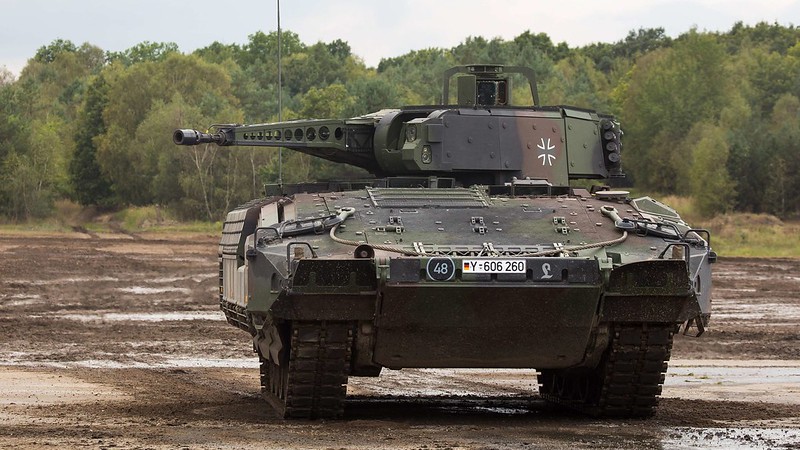The German Army Pumas disaster and the damaged prestige of the German industry
Many media have published this Monday that the German Army has had problems with its Puma "tanks", which affects its deployment with NATO.
The information was published this morning by the German newspaper Der Spiegel, which has released a confidential report by Major General Rupert von Butler of the German Army on the operability of the vehicles Puma from the 37th Panzer Grenadier Brigade "Freistaat Sachsen", a mechanized infantry unit attached to the 10th Armored Division.
Specifically,18 Pumas were rendered inoperative after some maneuvers by the aforementioned unit with a view to joining NATO's Very High Readiness Joint Task Force (VJTF) next year. All the Pumas that participated in the exercise ended up damaged mainly due to electronic problems in their turrets and, in one case, even causing a fire in the vehicle. The problem is such that this noon Germany has announced that it is stopping purchases of Puma vehicles.

To begin with, we must regret the lack of rigor that many media outlets have shown when publishing this information, using the word "tank" (a word that is commonly used to refer to tanks such as the Leopard 2, in the case of Germany) to refer to the Puma, which is an infantry fighting vehicle. It is an error that Der Spiegel has also made in its information, but in its case it has a small excuse: in German, a tank is "panzer" (a word that has its origins in the term used in other countries to refer to the part of medieval and modern armor that covered the torso: "pancera", in Spanish, and "panziera" in Italian), while infantry fighting vehicle is called "schützenpanzer" (literally something like "protected tank"). That may have been the source of journalistic confusion in other countries, but many journalists have not even bothered to review it.
Failures with VCI Puma are a serious problem for the German Army. In 2007, Germany contracted the purchase of 405 Pumas -not counting the 5 test vehicles delivered- to replace its already veteran Marder, an infantry fighting vehicle that was ahead of its time and in fact has had many imitators (the Swedish CV-90, the American M-2 Bradley and the Spanish ASCOD Pizarro are descendants of that concept). The initial consignment was reduced to 350 vehicles in 2012, with deliveries ending in August 2021.

Since its inception, the Puma has become a magnet for problems, with extra costs in production, excess weight of the vehicle (the German Armed Forces can only transport it in the Airbus A400M Atlas and after remove some of its protections to lighten it) and for numerous design and manufacturing defects, which include the clumsy choice of a coaxial machine gun of only 5.56 mm, instead of the usual 7.62 . These deficiencies have favored its main European competitor, the CV-90, which has ended up winning contracts in Denmark, Estonia, Finland, Norway, the Netherlands and Switzerland, in addition to the manufacturing country itself, Sweden, while Puma has only found potential export customers in Chile and Croatia.
The problems of the Puma have reached such an extreme that in 2019, the modernization of 41 of these vehicles was considered for their integration into the NATO VJTF, something surprising for a vehicle whose first units entered service in 2015. Just a few days ago, the German Parliament approved the budget for that modernization, in a truly disastrous situation for this model of vehicle: "only a small amount is in fully operational even years after it was presented to the troops", Augen Geradeaus, a specialized German website in defense, noted on December 14. This noon it has been known that Germany will turn to veteran Marder for NATO VJTF, hoping to resolve the Puma issues.

What happened with the Puma is not an isolated case. Last summer, problems with the German self-propelled howitzer Panzerhaubitze 2000, after 12 units donated by Germany and the Netherlands to Ukraine needed repairs to their guns as they could not withstand a rate of more than 100 shots diaries. The affected vehicles had to be repaired in Lithuania.
Add to that the poor experience with the Turkish Leopard 2 in Syria, largely attributable to unprepared crews of the Turkish Army, but which has contributed to diminishing the prestige of this excellent tank. It is significant that Leopard 2 user Poland has opted for the South Korean K2 Black Panther and American M1 Abrams, instead of buying more German tanks. Beyond the political reasons (the relations between Poland and Germany are not going through their best moment), this decision has been a hard blow for the country that makes the Leopard 2. The problems that have arisen with the Puma increase the damage to prestige of the German defense industry, one of the most powerful in Europe, and they do so at a time when the demand for military equipment is increasing due to the Russian invasion of Ukraine.
---
Photos: Bundeswehr.
|
Don't miss the news and content that interest you. Receive the free daily newsletter in your email: |
- Most read
- The 'hole' without civil flights around Paris during the opening of the Olympic Games
- Stunning footage of the F-15QA Ababil in flight recorded from its cockpit
- The firearms used by the Pontifical Swiss Guard, the smallest army in the world
- The most distant deployment of the Spanish Air Force in Australia and New Zealand
- Eurofighter vs F-35: the opinions of professional pilots on these advanced fighters
- The first photo of an F-16 fighter with Ukrainian insignia and the details it has revealed
- This is the driver station of an M1 Abrams tank and the impressive start of its engine

 ES
ES







Opina sobre esta entrada: